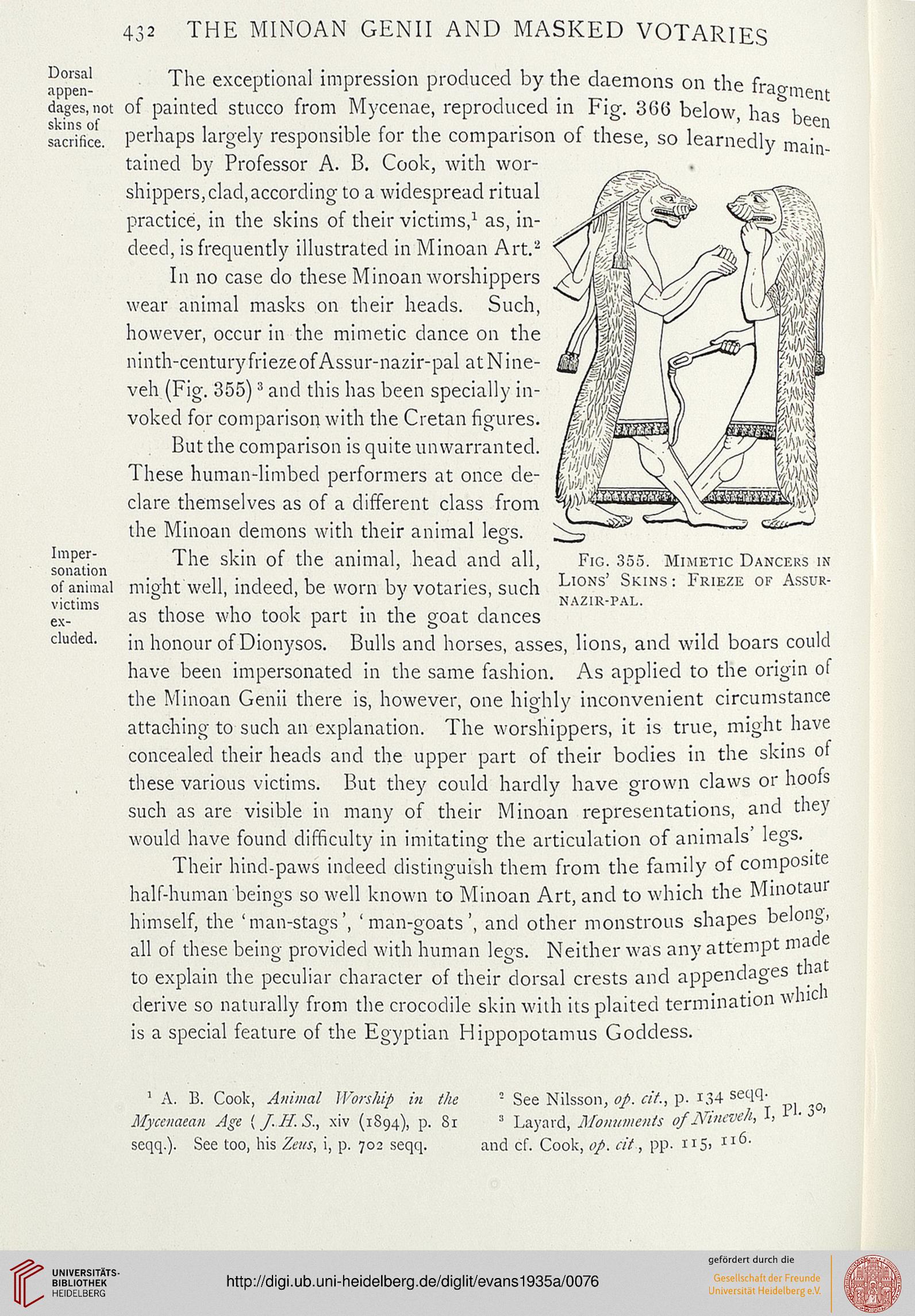432 THE MINOAN GENII AND MASKED VOTARIES
Dorsal
appen-
dages, not
skins of
sacrifice.
Imper-
sonation
of animal
victims
ex-
cluded.
w
The exceptional impression produced by the daemons on the frao-m
of painted stucco from Mycenae, reproduced in Fig. 366 below, has b
perhaps largely responsible for the comparison of these, so learnedly mai
tained by Professor A. B. Cook, with wor-
shippers, clad, according to a widespread ritual
practice, in the skins of their victims,1 as, in-
deed, is frequently illustrated in Minoan Art.2
In no case do these Minoan worshippers
wear animal masks on their heads. Such,
however, occur in the mimetic dance on the
ninth-century friezeofAssur-nazir-pal at Nine-
veh (Fig. 355)3 and this has been specially in-
voked for comparison with the Cretan figures.
. But the comparison is quite unwarranted.
These human-limbed performers at once de-
clare themselves as of a different class from
the Minoan demons with their animal legs.
The skin of the animal, head and all,
might well, indeed, be worn by votaries, such
as those who took part in the goat dances
in honour of Dionysos. Bulls and horses, asses, lions, and wild boars could
have been impersonated in the same fashion. As applied to the origin of
the Minoan Genii there is, however, one highly inconvenient circumstance
attaching to-such an explanation. The worshippers, it is true, might have
concealed their heads and the upper part of their bodies in the skins ot
these various victims. But they could hardly have grown claws or hoofs
such as are visible in many of their Minoan representations, and they
would have found difficulty in imitating the articulation of animals' legs.
Their hind-paws indeed distinguish them from the family of composite
half-human beings so well known to Minoan Art, and to which the Minotaui
himself, the 'man-stags', 'man-goats', and other monstrous shapes belong
all of these beino- provided with human lees. Neither was any attempt m
i tint
to explain the peculiar character of their dorsal crests and appendages
derive so naturally from the crocodile skin with its plaited termination w
is a special feature of the Egyptian Hippopotamus Goddess.
Fig. 355. Mimetic Dancers in
Lions' Skins : Frieze of Assur-
nazir-pal.
de
vhich
1 A. B. Cook, Animal Warship in the
Mycenaean Age {J.H.S., xiv (1S94), p. Si
seqq.). See too, his Zeus, i, p. 702 seqq.
! See Nilsson, op. tit., p. 134 sec11-
» Layard, Monuments of Nineveh, I, r • * •
and cf. Cook, op. cit, pp. "S. Il6'
Dorsal
appen-
dages, not
skins of
sacrifice.
Imper-
sonation
of animal
victims
ex-
cluded.
w
The exceptional impression produced by the daemons on the frao-m
of painted stucco from Mycenae, reproduced in Fig. 366 below, has b
perhaps largely responsible for the comparison of these, so learnedly mai
tained by Professor A. B. Cook, with wor-
shippers, clad, according to a widespread ritual
practice, in the skins of their victims,1 as, in-
deed, is frequently illustrated in Minoan Art.2
In no case do these Minoan worshippers
wear animal masks on their heads. Such,
however, occur in the mimetic dance on the
ninth-century friezeofAssur-nazir-pal at Nine-
veh (Fig. 355)3 and this has been specially in-
voked for comparison with the Cretan figures.
. But the comparison is quite unwarranted.
These human-limbed performers at once de-
clare themselves as of a different class from
the Minoan demons with their animal legs.
The skin of the animal, head and all,
might well, indeed, be worn by votaries, such
as those who took part in the goat dances
in honour of Dionysos. Bulls and horses, asses, lions, and wild boars could
have been impersonated in the same fashion. As applied to the origin of
the Minoan Genii there is, however, one highly inconvenient circumstance
attaching to-such an explanation. The worshippers, it is true, might have
concealed their heads and the upper part of their bodies in the skins ot
these various victims. But they could hardly have grown claws or hoofs
such as are visible in many of their Minoan representations, and they
would have found difficulty in imitating the articulation of animals' legs.
Their hind-paws indeed distinguish them from the family of composite
half-human beings so well known to Minoan Art, and to which the Minotaui
himself, the 'man-stags', 'man-goats', and other monstrous shapes belong
all of these beino- provided with human lees. Neither was any attempt m
i tint
to explain the peculiar character of their dorsal crests and appendages
derive so naturally from the crocodile skin with its plaited termination w
is a special feature of the Egyptian Hippopotamus Goddess.
Fig. 355. Mimetic Dancers in
Lions' Skins : Frieze of Assur-
nazir-pal.
de
vhich
1 A. B. Cook, Animal Warship in the
Mycenaean Age {J.H.S., xiv (1S94), p. Si
seqq.). See too, his Zeus, i, p. 702 seqq.
! See Nilsson, op. tit., p. 134 sec11-
» Layard, Monuments of Nineveh, I, r • * •
and cf. Cook, op. cit, pp. "S. Il6'




